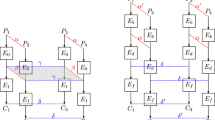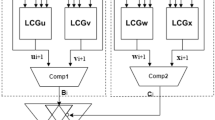Abstract
A template attack, the most powerful side-channel attack methods, usually first builds the leakage profiles from a controlled profiling device, and then uses these profiles to recover the secret of the target device. It is based on the fact that the profiling device shares similar leakage characteristics with the target device. In this study, we focus on the similar operations in a single device and propose a new variant of the template attack, called the similar operation template attack (SOTA). SOTA builds the models on public variables (e.g., input/output) and recovers the values of the secret variables that leak similar to the public variables. SOTA’s advantage is that it can avoid the requirement of an additional profiling device. In this study, the proposed SOTA method is applied to a straightforward RSA-CRT implementation. Because the leakage is (almost) the same in similar operations, we reduce the security of RSA-CRT to a hidden multiplier problem (HMP) over GF(q), which can be solved byte-wise using our proposed heuristic algorithm. The effectiveness of our proposed method is verified as an entire prime recovery procedure in a practical leakage scenario.
Similar content being viewed by others
References
Kocher P C, Jaffe J, Jun B. Differential power analysis. In: Advances in Cryptology — CRYPTO’99. Berlin: Springer, 1999. 15–19
Brier E, Clavier C, Olivier F. Correlation power analysis with a leakage model. In: Proceedings of International Workshop on Cryptographic Hardware and Embedded Systems. Berlin: Springer, 2004. 16–29
Gierlichs B, Batina L, Tuyls P. Mutual information analysis. In: Proceedings of International Workshop on Cryptographic Hardware and Embedded Systems. Berlin: Springer, 2008. 426–442
Batina L, Gierlichs B, Lemke-Rust K. Differential cluster analysis. In: Cryptographic Hardware and Embedded Systems–CHE 2009 Lausanne. Berlin: Springer, 2009. 112–127
Chari S, Rao J R, Rohatgi P. Template attacks. In: Proceedings of International Workshop on Cryptographic Hardware and Embedded Systems. Berlin: Springer, 2002. 13–28
Amiel F, Feix B, Villegas K. Power analysis for secret recovering and reverse engineering of public key algorithms. In: Proceedings of International Workshop on Selected Areas in Cryptography. Berlin: Springer, 2007. 110–125
Balasch J, Gierlichs B, Reparaz O, et al. DPA, bitslicing and masking at 1 GHz. In: Proceedings of International Workshop on Cryptographic Hardware and Embedded Systems. Berlin: Springer, 2015. 599–619
Tang M, Qiu Z L, Peng H B, et al. Toward reverse engineering on secret S-boxes in block ciphers. Sci China Inf Sci, 2014, 57: 032208
Genkin D, Adi Shamir A, Tromer E. RSA Key Extraction via low-bandwidth acoustic cryptanalysis. In: Proceedings of Advances in Cryptology — CRYPTO 2014. Berlin: Springer, 2014. 444–461
Genkin D, Pipman I, Tromer E. Get your hands off my laptop: physical side-channel key-extraction attacks on PCs. In: Proceedings of International Workshop on Cryptographic Hardware and Embedded Systems. Berlin: Springer, 2014. 242–260
Genkin D, Pachmanov L, Pipman I, et al. Stealing keys from PCs using a radio: cheap electromagnetic attacks on windowed exponentiation. In: Proceedings of International Workshop on Cryptographic Hardware and Embedded Systems. Berlin: Springer, 2015. 207–228
Genkin D, Pachmanov L, Pipman I, et al. ECDSA key extraction from mobile devices via nonintrusive physical side channels. In: Proceedings of the 2016 ACM SIGSAC Conference on Computer and Communications Security, Vienna, 2016. 1626–1638
Belgarric P, Fouque P A, Macario-Rat G, et al. Side-channel analysis of Weierstrass and Koblitz curve ECDSA on Android smartphones. In: Proceedings of the Cryptographers’ Track at the RSA Conference 2016. Cham: Springer, 2016. 236–252
Coppersmith D. Small solutions to polynomial equations, and low exponent RSA vulnerabilities. J Cryptol, 1997, 10: 233–260
Joye M, Yen S M. The montgomery powering ladder. In: Proceedings of Cryptographic Hardware and Embedded Systems, Redwood Shores, 2002. 291–302
Chevallier-Mames B, Ciet M, Joye M. Low-cost solutions for preventing simple side-channel analysis: side-channel atomicity. IEEE Trans Comp, 2004, 53: 760–768
Brier É, Joye M. Weierstraß Elliptic curves and side-channel attacks. In: Proceedings of International Workshop on Public Key Cryptography. Berlin: Springer, 2002. 2274: 335–345
Sinha Roy S, Järvinen K, Verbauwhede I. Lightweight coprocessor for Koblitz curves: 283-Bit ECC including scalar conversion with only 4300 gates. In: Proceedings of International Workshop on Cryptographic Hardware and Embedded Systems. Berlin: Springer, 2015. 102–122
Witteman M. A DPA attack on RSA in CRT mode. Riscure Technical Report, 2009. https://www.riscure.com/archive/DPA attack on RSA in CRT mode.pdf.
Aldaya A C, Sarmiento A J C, Sánchez-Solano S. SPA vulnerabilities of the binary extended Euclidean algorithm. J Cryp Eng, 2016, 7: 273–285
Walter C D. Sliding windows succumbs to big Mac attack. In: Proceedings of International Workshop on Cryptographic Hardware and Embedded Systems. Berlin: Springer, 2001. 286–299
Montminy D P, Baldwin R O, Temple M A, et al. Improving cross-device attacks using zero-mean unit-variance normalization. J Cryp Eng, 2013, 3: 99–110
Standaert F X, Archambeau C. Using subspace-based template attacks to compare and combine power and electromagnetic information leakages. In: Proceedings of International Workshop on Cryptographic Hardware and Embedded Systems. Berlin: Springer, 2008. 411–425
Archambeau C, Peeters E, Standaert F X, et al. Template attacks in principal subspaces. In: Proceedings of International Workshop on Cryptographic Hardware and Embedded Systems. Berlin: Springer, 2006. 1–14
Hospodar G, Gierlichs B, De Mulder E, et al. Machine learning in side-channel analysis: a first study. J Cryp Eng, 2011, 1: 293–305
Lerman L, Bontempi G, Markowitch O, et al. Power analysis attack: an approach based on machine learning. Int J Appl Cryp, 2014, 3: 97–115
Choudary O, Kuhn M G. Template attacks on different devices. In: Proceedings of International Workshop on Constructive Side-Channel Analysis and Secure Design. Cham: Springer, 2014. 179–198
Whitnall C, Oswald E. Robust profiling for DPA-style attacks. In: Proceedings of International Workshop on Cryptographic Hardware and Embedded Systems. Berlin: Springer, 2015. 3–21
Rivest R L, Shamir A, Adleman LM. A method for obtaining digital signatures and public-key cryptosystems. Commun ACM, 1983, 21: 96–99
Quisquater J J. Fast decipherment algorithm for RSA public-key cryptosystem. Electron Lett, 2007, 18: 905–907
Choudary O, Kuhn M G. Efficient template attacks. In: Proceedings of International Conference on Smart Card Research and Advanced Applications. Cham: Springer, 2013. 253–270
Belaïd S, Fouque P A, Gérard B. Side-channel analysis of multiplications in GF(2128)-application to AES-GCM. In: Proceedings of International Conference on the Theory and Application of Cryptology and Information Security. Berlin: Springer, 2014. 306–325
Belaïd S, Coron J S, Fouque P A, et al. Improved side-channel analysis of finite-field multiplication. In: Proceedings of International Workshop on Cryptographic Hardware and Embedded Systems. Berlin: Springer, 2015. 395–415
Merino Del Pozo S, Standaert F X. Blind source separation from single measurements using singular spectrum analysis. In: Proceedings of International Workshop on Cryptographic Hardware and Embedded Systems, Saint-Malo, 2015. 42–59
Renauld M, Standaert F X, Veyrat-Charvillon N, et al. A formal study of power variability issues and side-channel attacks for nanoscale devices. In: Advances in Cryptology — EUROCRYPT 2011. Berlin: Springer, 2011. 109–128
Acknowledgements
This work was supported by Major State Basic Research Development Program (973 Program) (Grant No. 2013CB338004), National Natural Science Foundation of China (Grant Nos. U1536103, 61402286, 61472249, 61602239, 61572192, 61472250), Minhang District Cooperation Plan (Grant No. 2016MH310), and Natural Science Foundation of Jiangsu Province (Grant No. BK20160808).
Author information
Authors and Affiliations
Corresponding authors
Rights and permissions
About this article
Cite this article
Xu, S., Lu, X., Zhang, K. et al. Similar operation template attack on RSA-CRT as a case study. Sci. China Inf. Sci. 61, 032111 (2018). https://doi.org/10.1007/s11432-017-9210-3
Received:
Revised:
Accepted:
Published:
DOI: https://doi.org/10.1007/s11432-017-9210-3




